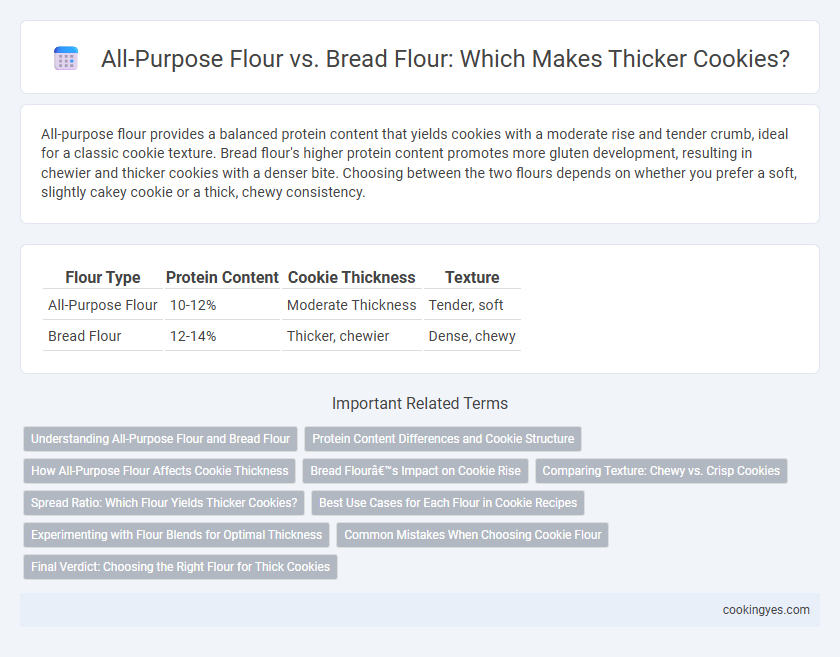All-purpose flour provides a balanced protein content that yields cookies with a moderate rise and tender crumb, ideal for a classic cookie texture. Bread flour's higher protein content promotes more gluten development, resulting in chewier and thicker cookies with a denser bite. Choosing between the two flours depends on whether you prefer a soft, slightly cakey cookie or a thick, chewy consistency.
Table of Comparison
| Flour Type | Protein Content | Cookie Thickness | Texture |
|---|---|---|---|
| All-Purpose Flour | 10-12% | Moderate Thickness | Tender, soft |
| Bread Flour | 12-14% | Thicker, chewier | Dense, chewy |
Understanding All-Purpose Flour and Bread Flour
All-purpose flour has a moderate protein content, typically around 10-12%, which balances tenderness and structure in cookies, resulting in a softer, slightly thinner texture. Bread flour contains higher protein, usually 12-14%, which develops more gluten and creates chewier, thicker cookies with more chew and a dense crumb. Using all-purpose flour yields cookies with a tender bite and moderate thickness, while bread flour offers increased thickness and chewiness due to its stronger gluten network.
Protein Content Differences and Cookie Structure
All-purpose flour typically contains 10-12% protein, providing moderate gluten development that results in cookies with a balanced texture and slight chewiness. Bread flour, with a higher protein content of 12-14%, promotes stronger gluten formation, producing thicker, denser cookies with a chewier structure. The increased protein in bread flour enhances the cookie's ability to trap air and moisture, contributing to a more substantial and structured bite.
How All-Purpose Flour Affects Cookie Thickness
All-purpose flour's moderate protein content, typically around 10-12%, results in a balanced gluten formation that yields cookies with a tender yet slightly firm texture. This flour variety absorbs moisture in a way that allows cookies to spread more during baking, often producing thinner, crispier edges while maintaining a soft center. Using all-purpose flour generally leads to cookies with less rise and thickness compared to bread flour, which has a higher protein content and creates a denser dough structure.
Bread Flour’s Impact on Cookie Rise
Bread flour's higher protein content produces more gluten, which traps air and steam during baking, resulting in thicker, chewier cookies with greater rise. Compared to all-purpose flour, bread flour enhances cookie structure by providing increased elasticity and moisture retention. This makes bread flour ideal for recipes where a thicker, loftier cookie texture is desired.
Comparing Texture: Chewy vs. Crisp Cookies
All-purpose flour produces cookies with a balanced texture, offering a moderate chewiness and slight crispness due to its medium protein content of around 10-12%. Bread flour, containing higher protein levels (12-14%), develops more gluten, resulting in chewier, denser cookies with less crispness. Choosing bread flour enhances chewiness but may reduce the delicate crisp edges typical of cookies made with all-purpose flour.
Spread Ratio: Which Flour Yields Thicker Cookies?
Bread flour, with its higher protein content (12-14%), yields thicker cookies by promoting more gluten formation, which enhances dough strength and reduces spread ratio compared to all-purpose flour (10-12% protein). The lower protein in all-purpose flour results in less gluten development and greater cookie spread, producing thinner, crisper edges. Using bread flour optimizes cookie thickness by limiting spread, achieving a chewier, denser texture favored in thicker cookie recipes.
Best Use Cases for Each Flour in Cookie Recipes
All-purpose flour provides a balanced protein content ideal for tender, slightly chewy cookies with moderate thickness, making it versatile for most cookie recipes including chocolate chip and sugar cookies. Bread flour, with higher protein levels, promotes more gluten development, resulting in denser, chewier cookies with greater thickness, perfect for heartier cookie styles like chewy oatmeal or thick sandwich cookies. Choosing the right flour depends on desired texture: all-purpose for softness and moderate rise, bread flour for robust chew and substantial structure.
Experimenting with Flour Blends for Optimal Thickness
Experimenting with flour blends reveals that combining all-purpose and bread flour can enhance cookie thickness by balancing gluten formation and moisture retention. All-purpose flour's moderate protein content provides tenderness, while bread flour's higher protein strengthens dough structure, resulting in chewier, thicker cookies. Adjusting ratios allows bakers to customize cookie texture, achieving the ideal balance between softness and density for optimal thickness.
Common Mistakes When Choosing Cookie Flour
Using all-purpose flour instead of bread flour often results in cookies with less chewiness and thickness due to lower protein content, which affects gluten development. A common mistake is assuming bread flour will always yield thicker cookies, but its higher protein level can sometimes create denser cookies rather than soft and airy ones. Understanding the protein content and desired cookie texture is essential to choosing between all-purpose and bread flour for optimal thickness and chewiness.
Final Verdict: Choosing the Right Flour for Thick Cookies
All-purpose flour provides a balanced protein content of around 10-12%, resulting in cookies with moderate thickness and tenderness. Bread flour, with its higher protein content of 12-14%, develops more gluten, producing thicker, chewier cookies ideal for a hearty texture. For thick cookies, bread flour is the optimal choice to achieve a denser, more substantial bite without sacrificing softness.
All-purpose flour vs bread flour for cookie thickness Infographic

 cookingyes.com
cookingyes.com